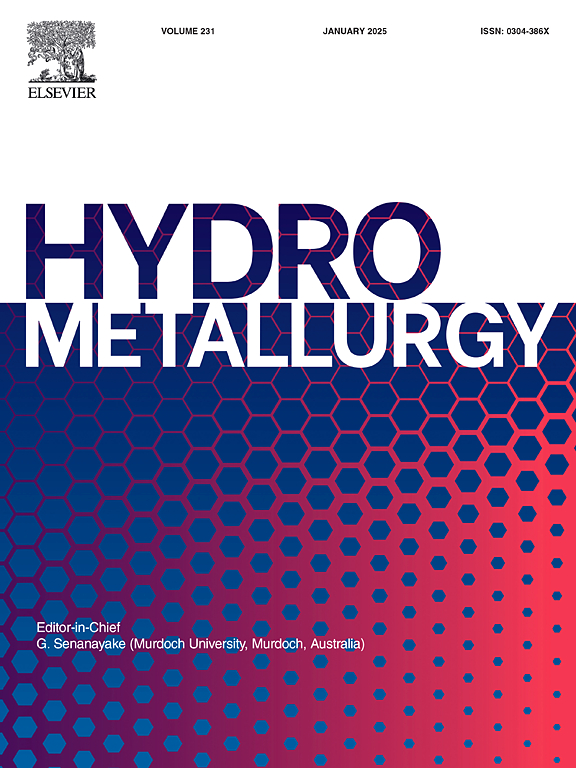A preliminary study of a sequential leaching process to recover Ag, Au, Cu, and Sn from E-waste
IF 4.8
2区 材料科学
Q1 METALLURGY & METALLURGICAL ENGINEERING
引用次数: 0
Abstract
The rapid growth of electronic waste (e-waste) presents both environmental challenges and economic opportunities. This study investigates efficient methods for recovering valuable metals from printed circuit boards (PCBs) using hydrometallurgical processes. The PCB samples from various end-of-life electronic devices were subjected to a series of five leaching stages targeting the leaching of Ag, Au, Cu, and Sn. The first stage using 3 mol/L nitric acid achieved 97 % Cu leaching, reducing Cu content from an average of 20 % (w/w) to 0.74 % (w/w). This stage also affected other metals, leaching 53 % of Ag and 78 % of Sn. Subsequent leaching with thiourea in acidic media containing Fe(NO3)3 leached 75 % of Au. An iodine/iodide leach with H2O2 as an oxidizer proved highly effective for Ag, with 99 % leaching. This stage also leached an additional 62 % of Au. Two methods for Sn leaching were compared: HCl leaching achieved 98 % efficiency; H2SO4 with CuSO4 also achieved 98 % leaching efficiency. Inductively Coupled Plasma Optical Emission Spectrometry (ICP OES) was used to analyze metal concentrations throughout the process. This sequential leaching approach demonstrates the potential for high-efficiency recovery of valuable metals from e-waste, contributing to both economic benefits and environmental sustainability in electronic waste management. The study highlights the complexity of metal interactions with leaching reagents and the importance of optimizing each stage for selective and efficient recovery of metals from e-waste.
从电子垃圾中回收银、金、铜、锡的顺序浸出工艺初步研究
电子垃圾的快速增长既带来了环境挑战,也带来了经济机遇。本研究探讨了利用湿法冶金工艺从印刷电路板(pcb)中回收有价金属的有效方法。来自各种报废电子设备的PCB样品进行了一系列的五个浸出阶段,目标是Ag, Au, Cu和Sn的浸出。第一阶段采用3 mol/L硝酸浸出,铜浸出率达到97%,铜含量由平均20% (w/w)降至0.74% (w/w)。这一阶段也影响了其他金属,浸出了53%的银和78%的锡。随后用硫脲在含Fe(NO3)3的酸性介质中浸出75%的Au。以H2O2为氧化剂的碘/碘化物浸出对银非常有效,浸出率达99%。这一阶段还额外浸出了62%的金。两种浸锡方法的比较:HCl浸锡率达98%;H2SO4与CuSO4的浸出率也达到98%。电感耦合等离子体光学发射光谱法(ICP OES)用于分析整个过程中的金属浓度。这种顺序浸出方法证明了从电子废物中高效回收有价值金属的潜力,有助于电子废物管理的经济效益和环境可持续性。该研究强调了金属与浸出试剂相互作用的复杂性,以及优化每个阶段对从电子废物中选择性和有效地回收金属的重要性。
本文章由计算机程序翻译,如有差异,请以英文原文为准。
求助全文
约1分钟内获得全文
求助全文
来源期刊

Hydrometallurgy
工程技术-冶金工程
CiteScore
9.50
自引率
6.40%
发文量
144
审稿时长
3.4 months
期刊介绍:
Hydrometallurgy aims to compile studies on novel processes, process design, chemistry, modelling, control, economics and interfaces between unit operations, and to provide a forum for discussions on case histories and operational difficulties.
Topics covered include: leaching of metal values by chemical reagents or bacterial action at ambient or elevated pressures and temperatures; separation of solids from leach liquors; removal of impurities and recovery of metal values by precipitation, ion exchange, solvent extraction, gaseous reduction, cementation, electro-winning and electro-refining; pre-treatment of ores by roasting or chemical treatments such as halogenation or reduction; recycling of reagents and treatment of effluents.
 求助内容:
求助内容: 应助结果提醒方式:
应助结果提醒方式:


